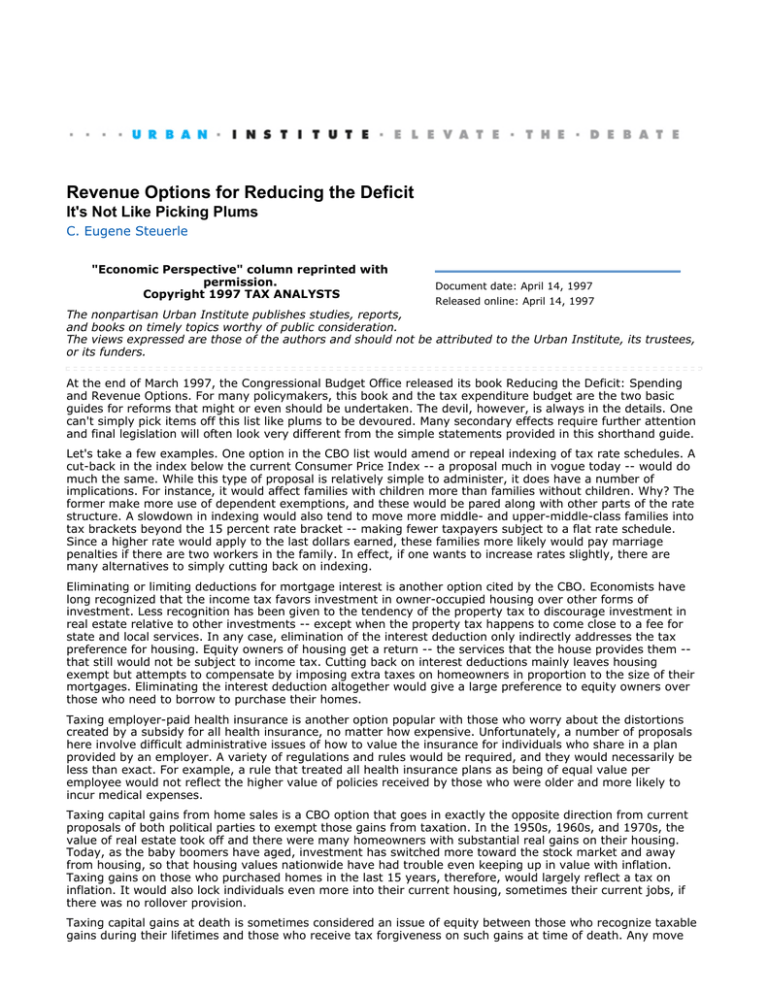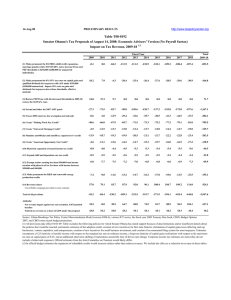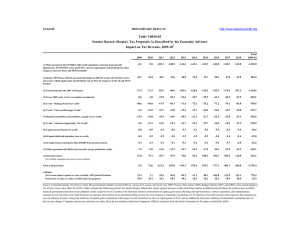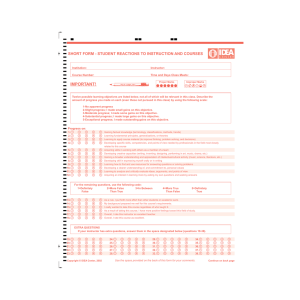Revenue Options for Reducing the Deficit It's Not Like Picking Plums
advertisement

Revenue Options for Reducing the Deficit It's Not Like Picking Plums C. Eugene Steuerle "Economic Perspective" column reprinted with permission. Copyright 1997 TAX ANALYSTS Document date: April 14, 1997 Released online: April 14, 1997 The nonpartisan Urban Institute publishes studies, reports, and books on timely topics worthy of public consideration. The views expressed are those of the authors and should not be attributed to the Urban Institute, its trustees, or its funders. At the end of March 1997, the Congressional Budget Office released its book Reducing the Deficit: Spending and Revenue Options. For many policymakers, this book and the tax expenditure budget are the two basic guides for reforms that might or even should be undertaken. The devil, however, is always in the details. One can't simply pick items off this list like plums to be devoured. Many secondary effects require further attention and final legislation will often look very different from the simple statements provided in this shorthand guide. Let's take a few examples. One option in the CBO list would amend or repeal indexing of tax rate schedules. A cut-back in the index below the current Consumer Price Index -- a proposal much in vogue today -- would do much the same. While this type of proposal is relatively simple to administer, it does have a number of implications. For instance, it would affect families with children more than families without children. Why? The former make more use of dependent exemptions, and these would be pared along with other parts of the rate structure. A slowdown in indexing would also tend to move more middle- and upper-middle-class families into tax brackets beyond the 15 percent rate bracket -- making fewer taxpayers subject to a flat rate schedule. Since a higher rate would apply to the last dollars earned, these families more likely would pay marriage penalties if there are two workers in the family. In effect, if one wants to increase rates slightly, there are many alternatives to simply cutting back on indexing. Eliminating or limiting deductions for mortgage interest is another option cited by the CBO. Economists have long recognized that the income tax favors investment in owner-occupied housing over other forms of investment. Less recognition has been given to the tendency of the property tax to discourage investment in real estate relative to other investments -- except when the property tax happens to come close to a fee for state and local services. In any case, elimination of the interest deduction only indirectly addresses the tax preference for housing. Equity owners of housing get a return -- the services that the house provides them -that still would not be subject to income tax. Cutting back on interest deductions mainly leaves housing exempt but attempts to compensate by imposing extra taxes on homeowners in proportion to the size of their mortgages. Eliminating the interest deduction altogether would give a large preference to equity owners over those who need to borrow to purchase their homes. Taxing employer-paid health insurance is another option popular with those who worry about the distortions created by a subsidy for all health insurance, no matter how expensive. Unfortunately, a number of proposals here involve difficult administrative issues of how to value the insurance for individuals who share in a plan provided by an employer. A variety of regulations and rules would be required, and they would necessarily be less than exact. For example, a rule that treated all health insurance plans as being of equal value per employee would not reflect the higher value of policies received by those who were older and more likely to incur medical expenses. Taxing capital gains from home sales is a CBO option that goes in exactly the opposite direction from current proposals of both political parties to exempt those gains from taxation. In the 1950s, 1960s, and 1970s, the value of real estate took off and there were many homeowners with substantial real gains on their housing. Today, as the baby boomers have aged, investment has switched more toward the stock market and away from housing, so that housing values nationwide have had trouble even keeping up in value with inflation. Taxing gains on those who purchased homes in the last 15 years, therefore, would largely reflect a tax on inflation. It would also lock individuals even more into their current housing, sometimes their current jobs, if there was no rollover provision. Taxing capital gains at death is sometimes considered an issue of equity between those who recognize taxable gains during their lifetimes and those who receive tax forgiveness on such gains at time of death. Any move to tax gains at death, however, is likely to require changes in estate taxes as well. The combination of the two taxes could impose very high tax rates on individuals, and the rate would be higher still if one took into account state income taxes and the so-called excess accumulations tax that applies to accumulations of pensions within the estate. When Canada moved toward taxation of gains at death, it eliminated the estate tax at the same time. Additional rules would also be required to deal with hard-to-value assets and assets purchased many years ago for which basis or original cost is hard to find or verify. One CBO option to curb tax subsidies for exports would cut back on the ability of domestic corporations to offset tax on their export income to the extent that they had excess foreign tax credits. If businesses no longer had this particular tax subsidy, however, they likely would engage in other activity to reduce further the probability they were in a position of excess foreign tax credits. Some additional mergers -- or reorganization of business to reduce excess foreign tax credit situations -- would be likely. None of these qualifications says that the types of revenue options listed by the CBO are without merit. What it does say is that it is unlikely that one can simply take items off of a laundry list and pull together a reform package. Other changes will often be required to compensate for unintended consequences, to provide exceptions for a group that would be unfairly treated, to substitute a more efficient program for the one being eliminated, or to ensure that the change does not add too much to tax complexity. This list, it should be remembered, is prepared mainly for deficit reduction in a period when national debt has been climbing at exorbitant rates for some time. It would be a less popular guide to policymakers if deficits were under control and they were looking for ways to spend additional revenues or to cut taxes. The tendency in budget deals of the past 15 years has been to amass a jumble of deficit reduction proposals that were acceptable to members of Congress and the president, often hitting weaker constituencies. That type of process by its very nature tends to discount broader issues of reform, such as just exactly where the whole system is headed once these multiple changes are made. Broader trade-offs for tax policy are often ignored. Seldom does this process tackle administrative issues, often leaving the tax system more complex than before. Despite these qualifications, the CBO's spending and revenue option book is a very valuable document. It provides useful short-hand summaries of many revenue options, and it demonstrates a wide range of techniques for broadening the tax base. It helps focus the attention of policymakers and lets them see how different options might be pulled together in a deficit reducing package. Like most travel guides, it is a useful summary but must be supplemented by other sources of information. Other Publications by the Authors C. Eugene Steuerle Usage and reprints: Most publications may be downloaded free of charge from the web site and may be used and copies made for research, academic, policy or other non-commercial purposes. Proper attribution is required. Posting UI research papers on other websites is permitted subject to prior approval from the Urban Institute—contact publicaffairs@urban.org. If you are unable to access or print the PDF document please contact us or call the Publications Office at (202) 261-5687. Disclaimer: The nonpartisan Urban Institute publishes studies, reports, and books on timely topics worthy of public consideration. The views expressed are those of the authors and should not be attributed to the Urban Institute, its trustees, or its funders. Copyright of the written materials contained within the Urban Institute website is owned or controlled by the Urban Institute. Source: The Urban Institute, © 2012 | http://www.urban.org





